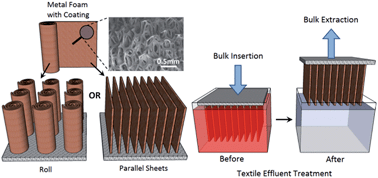Immobilization of dye pollutants on iron hydroxide coated substrates: kinetics, efficiency and the adsorption mechanism†
Abstract
Research on adsorbent materials has recently revolved around nanoparticles due to their enhanced surface area. However, they pose a major problem in terms of their removal and persistency in treated water, which is hazardous for consumption. This issue can be alleviated by immobilizing the pollutant on a rigid substrate. Using coated FeOOH porous thin films, we demonstrated a high adsorption capacity of 144 mg g−1 for Congo red that proved the viability of such an approach. The coated film therefore achieved unprecedented ease in separating the pollutant through immobilization. In addition, our film was grown using an environmentally friendly method at room temperature, making it highly attractive and scalable. Finally, we also examined the kinetics and adsorption mechanism of Congo red on FeOOH. We found that it is governed by a surface limited chemisorption reaction, through a unidentate complex bonding of Fe with the sulfonic group of the dye. We discussed the implication of such a mechanism by showing how the structure of our coated film plays a key role in affecting the adsorption capacity, and the theoretical limit of FeOOH adsorption.


 Please wait while we load your content...
Please wait while we load your content...